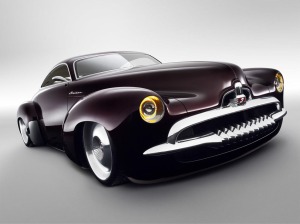The history of the automobile begins as early as 1769, with the creation of steam engined automobiles capable of human transport. In 1807, François Isaac de Rivaz designed the first car powered by an internal combustion engine running on fuel gas (hydrogen and oxygen), which -- although not in itself successful -- le d to the introduction of the ubiquitous modern gasoline- or petrol-fueled internal combustion engine in 1885.
The year 1886 is regarded the year of birth of the modern automobile - with the Benz Patent-Motorwagen, by German inventor Karl Benz
 Cars that are powered by electric power briefly appeared at the turn of the 20th century but largely disappeared from use until the turn of the 21st century. The early history of the automobile can be divided into a number of eras, based on the prevalent means of propulsion. Later periods were defined by trends in exterior styling, size, and utility preferences.
Cars that are powered by electric power briefly appeared at the turn of the 20th century but largely disappeared from use until the turn of the 21st century. The early history of the automobile can be divided into a number of eras, based on the prevalent means of propulsion. Later periods were defined by trends in exterior styling, size, and utility preferences.17th century - 18th century:
Ferdinand Verbiest, a member of a Jesuit mission in China, built the first steam-powered vehicle around 1672 as a toy for the Chinese Emperor. It was of small enough scale that it could not carry a driver but it was, quite possibly the first working steam-powered vehicle ('auto-mobile').
Steam-powered self-propelled vehicles large enough to transport people and cargo were first devised in the late 18th century. Nicolas-Joseph Cugnot demonstrated his fardier à vapeur ("steam dray"), an experimental steam-drivenartillery tractor, in 1770 and 1771. As Cugnot's design proved to be impractical, his invention was not developed in his native France. The centre of innovation shifted to Great Britain. By 1784, William Murdoch had built a working model of a steam carriage in Redruth, and in 1801 Richard Trevithick was running a full-sized vehicle on the roads in Camborne.[4] Such vehicles were in vogue for a time, and over the next decades such innovations as handbrakes, multi-speed transmissions, and better steering developed. Some were commercially successful in providing mass transit, until a backlash against these large speedy vehicles resulted in the passage of the Locomotive Act(1865), which required self-propelled vehicles on public roads in the United Kingdom to be preceded by a man on foot waving a red flag and blowing a horn. This effectively killed road auto development in the UK for most of the rest of the 19th century; inventors and engineers shifted their efforts to improvements in railway locomotives. (The law was not repealed until 1896, although the need for the red flag was removed in 1878.)
Compiled By:
Josh Martin

No comments:
Post a Comment